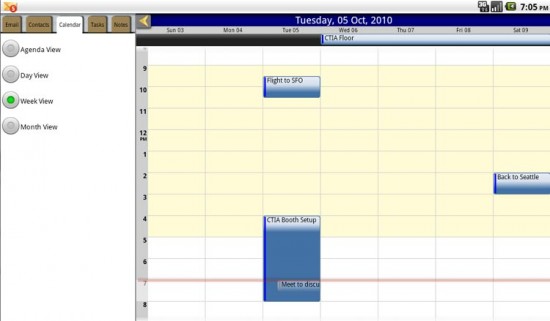A recent bit of news had Google expressly commenting that Android 2.2 wasn’t optimized for tablets, and the tech world immediately lost hope in currently announced tablets using that version of the OS and below. Instead the great Android tablet renaissance that was supposed to be coming this holiday season has been pushed back to early 2011 in anticipation of Android 3.0, an iteration of the OS that is being designed with slate devices in mind. Still, NitroDesk, developer of TouchDown Exchange for Android, is coming out saying despite what people have heard developing great looking apps for Android 2.2 tablets isn’t impossible.

We have seen it before in the Samsung Galaxy Tab, which gave a makeover to many core apps to properly take advantage of screen real estate. TouchDown has undergone the same tweaking, bringing about an app with split screen views to fill the entire large-resolution screen space. Here is what NitroDesk founder Goutham Sukumar had to say:
“Despite recent messages in the press about Android being not suitable for large screen devices, what we found is that the Android SDK is very capable of letting developers create applications which are optimized for tablet screens. While it is true that there are no separate controls for creating widgets like tree views and resizable splitters, it is quite possible to create applications which use the real estate effectively. It just requires some work on the developer’s part to get there.”
True, this is merely talking about the OS in terms of apps, and does point out that there are still quite a few limitations. But just like the iPad, regardless of the OS version on the tablet developers will always need to tweak their handheld apps to better fit screen real estate. NitroDesk will be showing off their new version of TouchDown next week at CTIA in San Francisco.
[via MobileBurn]










This just goes to show the true scalability of android even in its current form.
Didn’t one of the Android development managers also state that the Galaxy Tab was a teaching moment and that it didn’t take much additional work to get apps to work correctly on the 1024×600 screen?
IIRC, Android will automagically call for different assets from an app depending upon a device’s resolution. So, it comes down to dev’s creating an extra set of assets for a size range of x to y. Thus one app can work correctly and look custom-tailored across a wide range of device sizes.
The problem is that there are a vast number of devices out there with just 1.5. And those are in locations where it may not be easy for those folks to update. So you have to do some trickery rather than raise the minimum SDK (this info is on the Android developer site). And it depends on what your app is displaying. In some cases no work is necessary.
which is why we went to the extra effort to make sure that our large screen version works on 1.5/1.6 devices.
For example, it works very well on the Entourage EDGe device, running 1.6 and even the generic Chinese tablets, such as the Apad.
For those of you who might be coming to the CTIA show in SF next week, swing by booth #217, right next to the nice big Motorola booth and see the new toys. (and possibly some secret devices running the big screen version of TouchDown. :-)
Well, there is a huge difference between “not optimized” and “won’t work”. Of course it works fine. It’s just that it may not be as speedy, or even the default layouts may not be perfect. And this really only applies to large screens (larger than 5″) anyway. But as a dev you can still do it and it works just fine.
-Brad
By “works”, I mean that it displays properly and suffers no performance degradation.I guess that means it’s “optimized”. :-)
I am not a developer however I have been using/tweaking custom interface overlays on devices for a long time. I agree with Gunner. Applications will likely need a ‘For Tablets’ version of their products. As long as the industry does not go crazy with hardware differentiation-in other words, stays with the 1024 x 600 format as in the way Netbooks sort of standardized on that size at first it should work. If the market solidifys around the early core products then the hardware guys can differentiate all they want later. Meanwhile during the first phase they can tool up Android 3. That version could then be backwards compatible with the first core products specs as well as flexible enough to adapt to the inevitable hardware diversification.